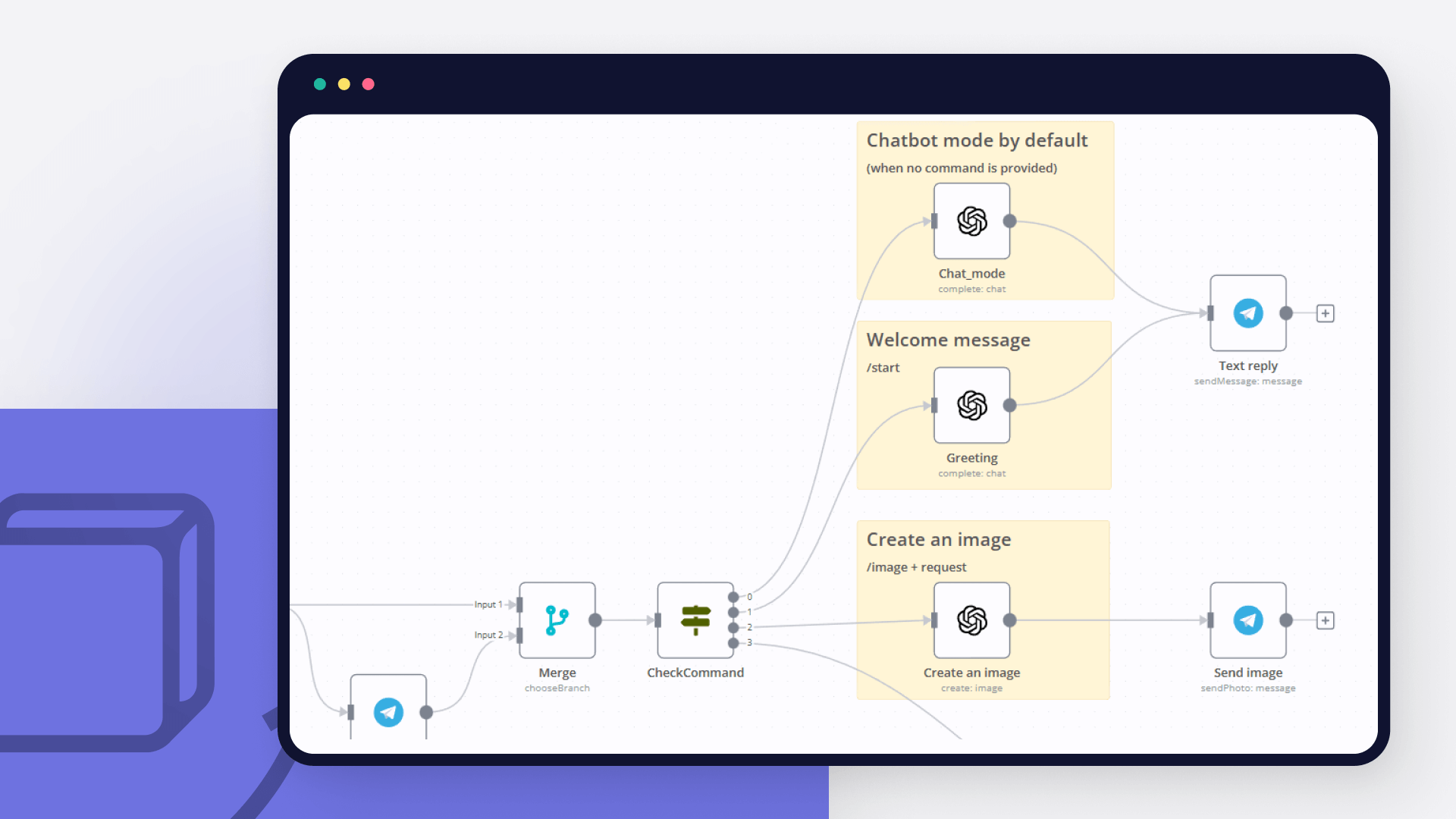Dock Certs and Telegram integration

How to connect Dock Certs and Telegram
Create a new workflow and add the first step
In n8n, click the "Add workflow" button in the Workflows tab to create a new workflow. Add the starting point – a trigger on when your workflow should run: an app event, a schedule, a webhook call, another workflow, an AI chat, or a manual trigger. Sometimes, the HTTP Request node might already serve as your starting point.
Build your own Dock Certs and Telegram integration
Create custom Dock Certs and Telegram workflows by choosing triggers and actions. Nodes come with global operations and settings, as well as app-specific parameters that can be configured. You can also use the HTTP Request node to query data from any app or service with a REST API.
Supported API Endpoints for Dock Certs
Revoke credential
This event indicates a credential has been revoked.
Unrevoke credential
This event indicates a credential has been unrevoked.
Issue Credential
Issues a new verifiable credential.
Get Credential
Retrieves a specific credential by ID.
Delete Credential
Deletes a specific credential from the system.
List credentials
Gets one or many credentials resources
Create credential
This event indicates a credential has been created.
Create credential
This event indicates a credential has been issued.
Issue credential
You can create and sign Verifiable Credentials on Dock Certs and its API.
Get credential
Fetches the credential associated with the given ID.
Create credential
Creates and issues a JSON-LD Verifiable Credential.
Request claims
Creates a request to gather certain claims and issues a credential after submission.
Get credentials metadata
Pull a list of credential metadata stored by the system for easy reference.
Create DID
Creates a new Decentralized Identifier (DID).
Get DID
Retrieves a specific Decentralized Identifier (DID).
List DIDs
Lists all Decentralized Identifiers (DIDs).
Delete DID
Deletes a specific Decentralized Identifier (DID).
Create DID
This event indicates a DID has been created.
Update key for DID
This event indicates a keyType value within the DID has been updated.
Update controller for DID
This event indicates a controller value within the DID has been updated.
Delete DID
This event indicates a DID has been deleted.
Create DID
Create a new Decentralized Identifier (DID).
Get DID
Retrieve a specific DID's details by its identifier.
Export DID
Export a specific DID by its identifier.
List DIDs
Return a list of all DIDs that your user account controls as fully resolved DID documents.
Delete DID
Deletes a DID and its metadata from the blockchain and our platform.
Create Profile
Creates a new profile in the system.
Get Profile
Retrieves a specific profile by ID.
List Profiles
Lists all profiles in the system.
Update Profile
Updates an existing profile in the system.
Delete Profile
Deletes a specific profile from the system.
Create Profile
Creates a new Organization Profile using the provided data.
Get Profile
Retrieves the Profile associated with the provided DID.
List profiles
Return a list of all Profiles that your user account controls.
Update profile
The update profile operation means that you can update the details of the profile.
Create Presentation
Creates a new presentation of credentials.
Create presentation
Create and sign a verifiable presentation out of one or more Verifiable Credentials.
Create Registry
Creates a new registry for credentials.
Create Schema
Creates a new credential schema.
Create anchor
This event indicates an anchor has been created.
Create did
Creates a new DID to issue with.
To set up Dock Certs integration, add the HTTP Request node to your workflow canvas and authenticate it using a generic authentication method. The HTTP Request node makes custom API calls to Dock Certs to query the data you need using the API endpoint URLs you provide.
See the example hereThese API endpoints were generated using n8n
n8n AI workflow transforms web scraping into an intelligent, AI-powered knowledge extraction system that uses vector embeddings to semantically analyze, chunk, store, and retrieve the most relevant API documentation from web pages. Remember to check the Dock Certs official documentation to get a full list of all API endpoints and verify the scraped ones!
Telegram supported actions
Get
Get up to date information about a chat
Get Administrators
Get the Administrators of a chat
Get Member
Get the member of a chat
Leave
Leave a group, supergroup or channel
Set Description
Set the description of a chat
Set Title
Set the title of a chat
Answer Query
Send answer to callback query sent from inline keyboard
Answer Inline Query
Send answer to callback query sent from inline bot
Get
Get a file
Delete Chat Message
Delete a chat message
Edit Message Text
Edit a text message
Pin Chat Message
Pin a chat message
Send Animation
Send an animated file
Send Audio
Send a audio file
Send Chat Action
Send a chat action
Send Document
Send a document
Send Location
Send a location
Send Media Group
Send group of photos or videos to album
Send Message
Send a text message
Send and Wait for Response
Send a message and wait for response
Send Photo
Send a photo
Send Sticker
Send a sticker
Send Video
Send a video
Unpin Chat Message
Unpin a chat message
Dock Certs and Telegram integration details
Dock Certs and Telegram integration tutorials

How to create an AI bot in Telegram
Learn how to create an AI chatbot for Telegram with our easy-to-follow guide. Ideal for users who are interested in exploring the realm of bot development without coding.

How to build a multilingual Telegram bot with low code
Learn how to build a multilingual bot for Telegram with a few lines of JavaScript code, a NocoDB database, and conditional logic in an automated workflow.

Create a toxic language detector for Telegram in 4 steps
Leverage the power of automation and machine learning to enable kinder online discussions.

6 e-commerce workflows to power up your Shopify store
Want to power up your online business and win back time? Discover how no-code workflow automation can help!

How to automate your reading habit just in time for World Poetry Day
Learn how to create a no-code workflow that gets international poems, translates them into one language, and sends you a poem in Telegram every day.

Using automation to boost productivity in the workplace
Instead of using IFTTT or Zapier, which can be pretty limiting on a free tier, I decided to try n8n, which is a fair-code licensed tool.
FAQ
Can Dock Certs connect with Telegram?
Can I use Dock Certs’s API with n8n?
Can I use Telegram’s API with n8n?
Is n8n secure for integrating Dock Certs and Telegram?
How to get started with Dock Certs and Telegram integration in n8n.io?
Need help setting up your Dock Certs and Telegram integration?
Discover our latest community's recommendations and join the discussions about Dock Certs and Telegram integration.
Looking to integrate Dock Certs and Telegram in your company?
The world's most popular workflow automation platform for technical teams including
Why use n8n to integrate Dock Certs with Telegram
Build complex workflows, really fast



